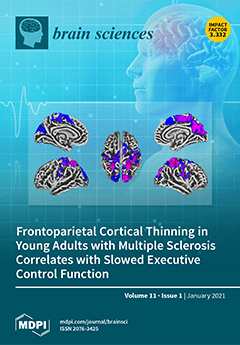Total CSF α-synuclein (t-α-syn), phosphorylated α-syn (pS129-α-syn) and α-syn oligomers (o-α-syn) have been studied as candidate biomarkers for synucleinopathies, with suboptimal specificity and sensitivity in the differentiation from healthy controls. Studies of α-syn species in patients with other underlying pathologies are lacking. The
[...] Read more.
Total CSF α-synuclein (t-α-syn), phosphorylated α-syn (pS129-α-syn) and α-syn oligomers (o-α-syn) have been studied as candidate biomarkers for synucleinopathies, with suboptimal specificity and sensitivity in the differentiation from healthy controls. Studies of α-syn species in patients with other underlying pathologies are lacking. The aim of this study was to investigate possible alterations in CSF α-syn species in a cohort of patients with diverse underlying pathologies. A total of 135 patients were included, comprising Parkinson’s disease (PD;
n = 13), multiple system atrophy (MSA;
n = 9), progressive supranuclear palsy (PSP;
n = 13), corticobasal degeneration (CBD;
n = 9), Alzheimer’s disease (AD;
n = 51), frontotemporal degeneration (FTD;
n = 26) and vascular dementia patients (VD;
n = 14). PD patients exhibited higher pS129-α-syn/α-syn ratios compared to FTD (
p = 0.045), after exclusion of samples with CSF blood contamination. When comparing movement disorders (i.e., MSA vs. PD vs. PSP vs. CBD), MSA patients had lower
α-syn levels compared to CBD (
p = 0.024). Patients with a synucleinopathy (PD and MSA) exhibited lower t-
α-syn levels (
p = 0.002; cut-off value: ≤865 pg/mL; sensitivity: 95%, specificity: 69%) and higher
pS129-/t-
α-syn ratios (
p = 0.020; cut-off value: ≥0.122; sensitivity: 71%, specificity: 77%) compared to patients with tauopathies (PSP and CBD). There are no significant α-syn species alterations in non-synucleinopathies.
Full article






